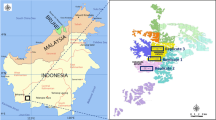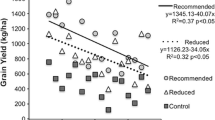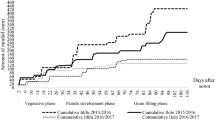Abstract
Many of the best management practices (BMPs) that are recommended for agricultural producers have not been scientifically evaluated for their conservation benefits considering the soil, climate, and hydrology of the proposed application location. The goal of this study was to compare royal palm (Roystonea elata) production in south Florida, USA, using tensiometer automated irrigation and reduced soil applications of nitrogen (N) and phosphorus (P), to that of traditional grower practices considering water savings, nutrient inputs, crop yield, crop nutrient status, soil nutrient status, and economic analyses. The study consisted of six treatments: (1) control (i.e., a grower irrigation rate and N and P fertilizer rates); (2) irrigation system automated to irrigate when soil water suction exceeded 5 kPa and the grower N and P rates; (3) irrigation system automated to irrigate when soil water suction exceeded 15 kPa and the grower N and P rates; (4) irrigation system automated to irrigate when soil water suction exceeded 15 kPa and 50% of the grower N and P rates; (5) the grower irrigation rate and 75% of the grower N and P rates; and (6) the grower irrigation rate and 50% of the grower N and P rates. Irrigation water volume applied, plant diameters, and plant heights were measured periodically throughout the study and plant tissue samples and soil samples were collected periodically for analysis of N and P content. Significant differences among treatments were only observed for the irrigation water volume applied. Automating the irrigation system to irrigate at soil suction exceeding 5 and 15 kPa resulted in 75 and 96% less water applied, respectively, than traditional irrigation scheduling practices used by a grower. Economic analyses suggested that all treatments would result in financial savings ranging from 7 to 34% per ha considering a 5-year, 2 ha investment. Thus, automating irrigation based on soil water suction for palm production in southern Florida, USA and similar locations will result in more sustainable agricultural production systems by benefiting the environment (less nutrients and water applied) and the grower (lower cost).






Similar content being viewed by others
References
Allen RG, Pereira LS, Raes D, Smith M (1998) Crop evapotranspiration—guidelines for computing crop water requirements, FAO Irrigation and drainage paper 56. Web site: http://www.fao.org/docrep/X0490E/x0490e00.HTM. Accessed 16 April 2008
Ayars JE, Schoneman RA (1986) Use of saline water from a shallow water table by cotton. Trans ASAE 29:1674–1678
Benz LC, Doering EJ, Recihman GA (1984) Water-table contribution to alfalfa evapotranspiration and yields in sandy soils. Trans ASAE 27:1307–1312
FDACS (Florida Department of Agricultural and Consumer Services) (2007) Best management practices rules, manuals, and other documents. Web site: http://www.floridaagwaterpolicy.com/BestManagementPractices.html. Accessed 16 April 2008
Hodges AW, Haydu JJ (2006) Economic impacts of the Florida environmental horticulture industry in 2005. FE675, a publication of Food and Resource Economics Department, Florida Cooperative Extension Service, University of Florida, Gainesville, FL. Web source: http://edis.ifas.ufl.edu/FE675. Accessed 14 April 2008
Kahlown MA, Ashraf M, Zia-ul-Haq (2005) Effect of shallow groundwater table on crop water requirements and crop yields. Agric Water Manag 76(1):24–35
Li YC (2001) Calcareous soils in Miami-Dade County. Fact Sheet SL 183, a publication of the Soil and Water Science Department, Florida Cooperative Extension Service, Institute of Food and Agricultural Sciences, University of Florida, Gainesville. Web site: http://edis.ifas.ufl.edu/TR004. Accessed 14 April 2008
Migliaccio KW, Schaffer B, Crane JH, Li YC, Muñoz-Carpena R (2008) Assessing capillary rise in a field nursery considering irrigation management. In: Proceedings from annual international ASABE meeting. St Joseph, MI
Minnesota IMPLAN Group, Inc. (2007), IMPLAN System (data and software), 1725 Tower Drive West, Suite 140, Stillwater, MN 55082. Web site: http://www.implan.com. Accessed 14 April 2008
Muñoz-Carpena R, Dukes MD, Li YC, Klassen W (2005a) Field comparison of tensiometer and granular matrix sensor automatic drip irrigation on tomato. Horttechnology 15(3):854–590
Muñoz-Carpena R, Li YC, Olczyk T (2005b) Alternatives of low cost soil moisture monitoring devices for vegetable production in south Miami-Dade County. ABE 333, Agricultural and Biological Engineering Department, Florida Cooperative Extension Service, Institute of Food and Agricultural Sciences, University of Florida: Gainesville, FL. http://edis.ifas.ufl.edu/AE230. Accessed: 14 April 2008
Muñoz-Carpena R, Dukes MD, Li YC, Klassen W (2008) Design and field evaluation of a new controller for soil water-based irrigation. Appl Eng Agric 24(2):183–191
Oki T, Kanae S (2006) Global hydrological cycles and world water resources. Science 313:1068–1072
Paramasivam S, Alva AK, Fares A (2000) An evaluation of soil water status using tensiometers in a sandy soil profile under citrus production. Soil Sci 165(4):343–353
Sepaskhah AR, Karimi-Goghari S (2005) Shallow groundwater contribution to pistachio water use. Agric Water Manag 72(1):69–80
SFWMD (South Florida Water Management District) (2007) Water supply. Web site: http://www.sfwmd.gov, https://my.sfwmd.gov/portal/page?_pageid=1874,4167309&_dad=portal&_schema=PORTAL&navpage=home. Accessed 14 April 2008
Shiklomanov IA (2000) Appraisal and assessment of world water resources. Water Int 25(1):11–32
Steele DD, Stegman EC, Knighton RE (2000) Irrigation management for corn in the northern Great Plains, USA. Irrigation Sci 19:107–114
US Census Bureau (2007) Census Bureau State and County QuickFacts. Web site: http://quickfacts.census.gov/qfd/index.html. Accessed 14 April 2008
USDA-NRCS (United States Department of Agriculture-Natural Resources Conservation Service) (1996) Soil survey of Dade County Area, FL
Wang Q, Klassen W, Abdul-Baki AA, Bryan HH, Li YC, Codallo M (2004) Influence of summer cover crops and irrigation rates on tomato yields and quality in a subtropical area. Proc Fla State Hort Soc 116:140–143
Acknowledgments
We would like to thank the grower and his farm manager for their excellent cooperation with this project. This project was funded by a USDA-CSREES National Integrated Water Grant. Successful completion of this project also required the assistance of many technicians and graduate students, with particular thanks going to Tina Dispenza and Michael Gutierrez. We would also like to thank several reviewers who assisted with improving this manuscript.
Author information
Authors and Affiliations
Corresponding author
Additional information
Communicated by J. Ayars.
Rights and permissions
About this article
Cite this article
Migliaccio, K.W., Schaffer, B., Li, Y.C. et al. Assessing benefits of irrigation and nutrient management practices on a southeast Florida royal palm (Roystonea elata) field nursery. Irrig Sci 27, 57–66 (2008). https://doi.org/10.1007/s00271-008-0121-4
Received:
Accepted:
Published:
Issue Date:
DOI: https://doi.org/10.1007/s00271-008-0121-4




